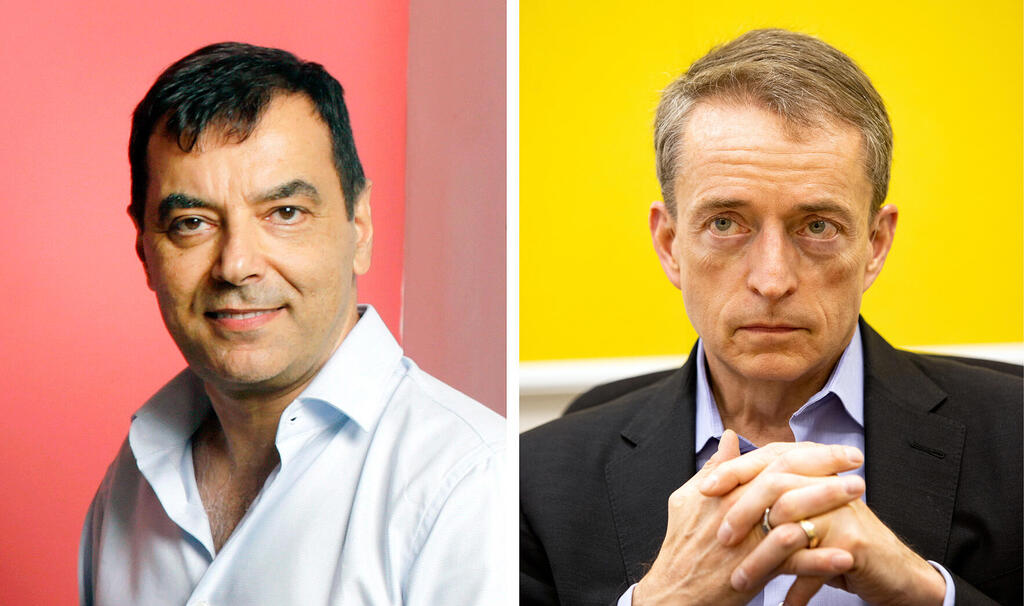
Analysis
Mobileye is seeking autonomy from Intel at all costs
Mobileye's IPO will be the largest ever by an Israeli company, yet it is still disappointing as the company will go public at the same value at which it was acquired by Intel 5 years ago, even though revenues have doubled
The largest Israeli IPO was launched yesterday as Mobileye submitted its updated prospectus with the full figures prior to beginning its road show, a series of meetings with investors. The road show should end in a week with the opening of trading in the stock next Wednesday under the new-old symbol MBLY.
Although Mobileye is being valued at approximately $15 billion, the highest ever for Israeli company going public, it is still a disappointing figure. The value, which is almost the same as the amount that Intel paid for Mobileye five years ago, reveals everything that the capital market already knew, but did not dare to say - Intel does not know how to make and manage acquisitions and Mobileye has not delivered on its autonomous vehicle promise.
Even if, as both Intel and Mobileye hope, the company will be the lone new issuance on Wall Street next week and with a bit of a headwind from investor sentiment, there will be excess demand and the value will reach $20 billion - the figure is far lower than expected. The IPO is led by almost all the major banks on Wall Street, with Goldman Sachs at the top, along with Citigroup, Morgan Stanley, Barclays and many others. In the offering, $250 million worth of shares will also be allocated to Mobileye employees. Employee compensation in Mobileye shares was one of the factors that pushed Mobileye founder Amnon Shashua to go public. This is in view of the ongoing drop in Intel shares, which lost more than half of their value in the last year and made it difficult for the company to attract engineers.
1 View gallery


Intel CEO Pat Gelsinger (right) and Mobileye founder Amnon Shashua.
(Photo: Alex Kolomoyski and Amit Shaal)
During the beginning of the IPO process almost a year ago, the bombastic announcement included a value of $50 billion in the IPO that would see Intel receive at least $3.5 billion. Now, even though all of the IPO proceeds will go to Intel, it will settle for just under $1 billion. In the offering, 41 million shares will be sold at a price range set at $18-20. This price reflects the raising of about $800 million according to a value of $14.5-$16 billion. Intel and Mobileye have already secured at least half of the offering with large chunks going to prominent institutional entities. The Norwegian wealth fund and one of Scotland's pension funds will purchase shares worth about $300 million, and at the same time as the offering, a private allocation will be made under the same conditions to the General Atlantic fund, which opened offices in Israel earlier this year. Also, in the prospectus, it is stated that the president and CEO of Mobileye, Amnon Shashua, asked to buy $10 million worth of shares.
All the shares in the offering will be sold by Intel, which will own 94.2% of the company after the completion of the IPO. This is the sale of a very small share of Mobileye - less than 6% - and Wall Street investors historically do not like IPOs that offer so few "goods". It seems that the meager number of shares is the result of a compromise between Intel, which would have preferred to wait a little longer for better days, and Shashua, who is pushing for an IPO to strengthen the brand of the company he founded to make it easier to deal with the intensifying competition from strong rivals such as Qualcomm and Nvidia. Both competitors are public companies that publish not only their results, but also technological announcements, big and small, and Mobileye feels that its activities are overshadowed by the great Intel.
Although Mobileye is the fastest growing and most profitable division within Intel, it is considered relatively small, generating about $1.5 billion out of the company’s annual revenue rate of $70 billion. Intel will wait for a recovery in the markets and an increase in the stock to sell another package of shares without an additional prospectus in about six months.
Shashua's desire to "be released" from the Intel prison and turn the spotlight on Mobileye's technology can be read between the lines of the letter he sent yesterday to 3,100 Mobileye employees. "Today we are starting the road show for Mobileye's IPO. The move will complete almost a year of preparations for Mobileye to become a public company. A year in which we saw tremendous progress in our performance and product portfolio, with an emphasis on Robotaxis. As a public company, we will be subject to market fluctuations, however, more importantly, we will receive credit for the unique value we are creating - the value of the technology, of the strategic plans, of the execution and of the financial growth," Shashua wrote. He then added an example. "To put things in context, imagine that the IPO is the first 100 meters in a marathon. What is important is where we will be many kilometers after the start of the race and not necessarily at the starting sprint. We are launching the IPO in very challenging times for global markets, but we believe we need to focus on the horizon. That's where our growth is."
So why are Pat Gelsinger, CEO of Intel, and Amnon Shashua, CEO of Mobileye, insisting on going public at all costs even though the market is tough? It's hard to argue with a billion dollars, but it's really what Intel needs after the surprising loss in the second quarter and the slowdown that has plagued the entire chip market since then. Intel needs cash to support expansion plans and the construction of new plants without giving up a dividend that would further hurt the battered stock.
It seems that Gelsinger, who was appointed only about a year ago and came out with an ambitious strategic plan, part of which was also to take Mobileye public by the end of 2022, does not want to be seen as someone who is folding while taking his first steps. Moreover, even if the market will now perceive the acquisition of Mobileye as a disappointment, Gelsinger, on his part, only signed off on the IPO and not the purchase made during the time of his predecessor Brian Krzanich. In this process, Intel's CEO transfers the burden of proof to Shashua and Mobileye, while receiving a dividend of $1 billion, and the proceeds of the IPO will go on Intel’s balance sheet. By the way, Mobileye already paid the parent company a dividend of $336 million last May as part of the move.
Mobileye is headed out on its own with a billion dollars in its coffers, but on the other hand, has a debt of $900 million to Intel for the purchase of Moovit for this amount in 2020. Intel was the buyer, but the deal was done for Mobileye and Moovit will now operate as its wholly owned subsidiary. Beyond this dowry, Mobileye also carries intangible assets that were created during its sale to Intel in 2017 and are now weighing on its profit line.
Before the publication of its numbers in the prospectus, Mobileye's results were partially incorporated into Intel's reports and showcased it as a profitable company. The large gap between the assets Mobileye had in 2017, when it was sold to Intel for $15.3 billion, led to the registration of a goodwill that now passes from Intel to Mobileye in the form of a clause of "reduction of intangible assets" and turned what was an operating profit into an operating loss. Even with the expense clauses, Mobileye has reduced the loss which amounted to $75 million in 2021 compared to $196 million in 2020 and $328 million in 2019. With the deductions, net profit was $474 million last year, a sharp increase from $289 million in 2020. The company has a positive flow from operations, but the main challenge for Mobileye is not the low value nor its balance sheet, rather its future.
In 2017, when Intel purchased it, the explanation the investors received was that the purchase was not made because of Mobileye's existing technology for ADAS systems to prevent accidents and driver alerts, but to gain a foothold in the autonomous vehicle market. However, in the meantime, their vision has already been postponed several times - from 2017 to 2019 and from there on to 2021. The vision has been updated from a transition to the autonomous vehicle in all parts of the market, to public transport only, from there to Robotaxis and trucks and currently it is still unclear where it is going and if it will leave the pilot stage in the near future. Although Mobileye has grown rapidly since the sale to Intel, the vast majority of its revenue comes from the sale of ADAS systems and not autonomous vehicles as Intel had expected.
At the time of the sale to Intel, Mobileye had important strategic agreements, the most prominent of which was with the car manufacturers BMW and Mercedes. Since then, they have also signed agreements with Mobileye's competitors and the competition in the markets it operates in is only increasing on more and more fronts. In the field of accident prevention systems, it faces Nvidia and Qualcomm, and in the autonomous vehicle market, it faces Tesla, Sony and even Apple, which is having great difficulty in developing the technology. Beyond that, it also has competition from companies that have specifically defined the Robotaxis market as their target, and here the main rival is Waymo in the U.S. and DiDi and Baidu in China. The market for driver assistance systems in which Mobileye was the global pioneer has matured, but it is not large and revolutionary enough to establish a value of tens of billions of dollars and is mainly on the way to becoming a relatively mature market in which profitability decreases as the products become a commodity. Already today, Mobileye's systems are integrated with 13 of the 15 largest car manufacturers in the world.
In the first half of 2022, Mobileye continued to grow and its revenues amounted to $854 million, an increase of 21% compared to the corresponding period. Yesterday the company also added performance for the third quarter of 2022 which indicated an acceleration in growth rates towards 40% which led to revenues of $450 million and an operating loss of $25 million. Excluding the deductions, it recorded a profit of $276 million in the first half of the year and an operating profit of about $140 million in the third quarter.
From now on, both companies share the same goal - to grow and contend with the difficult competition in the relevant markets. Shashua, a talented manager who has brought Mobileye to two successful exits - both in the first offering and in the sale, will have to remember how to be a completely independent and transparent company, away from Intel. The lack of transparency had its upsides such as hiding flaws or challenges that will now be exposed for all to see. Mobileye's main challenge will be to justify its value minus the dream of the autonomous vehicle market that hangs over its head like the intangible asset that Intel burdened it with at the time of separation.














